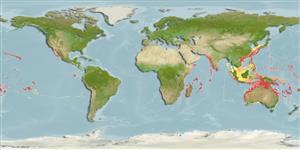Environment: milieu / climate zone / depth range / distribution range
Écologie
marin récifal; non migrateur; profondeur 20 - 110 m (Ref. 90102). Tropical
Western Indian Ocean: South Africa, Mauritius, Reunion. Pacific Ocean: Ryukyu Islands (Ref. 559), Taiwan, and from the Society, Cook, Marquesan, Tuamoto, Pitcairn and Hawaiian islands.
Taille / Poids / Âge
Maturity: Lm ? range ? - ? cm
Max length : 13.0 cm TL mâle / non sexé; (Ref. 3921)
Épines dorsales (Total) : 12; Rayons mous dorsaux (Total) : 8 - 9; Épines anales: 3; Rayons mous anaux: 5. Anterior part of dorsal fin resembles a small fish, the fin also has a spot between spines 1-2 or 1-3 (Ref. 4313). Lachrymal bone with 2 spines over maxillary, first points forward, second broad, pointing out and to rear; suborbital ridge without spines except one at rear before opercle; preopercular spines short, usually only 3 developed; no supplemental preopercular spine at base of first spine; a dark spot on the spinous dorsal fin between spines 1 or 2 and 3; and vertical scale rows of about 65-75 (Ref. 10482).
Found on sand and rubble under ledges of seaward reefs (Ref. 9710). Benthic (Ref. 58302). The dorsal fin mimics a tiny fish and is used as a lure (Ref. 9710). Anterolateral glandular groove with venom gland (Ref. 57406).
Life cycle and mating behavior
Maturité | Reproduction | Frai | Œufs | Fécondité | Larves
Randall, J.E., 1985. Guide to Hawaiian reef fishes. Harrowood Books, Newtown Square, PA 19073, USA. 74 p. (Ref. 3921)
Statut dans la liste rouge de l'IUCN (Ref. 130435: Version 2024-1)
Utilisations par l'homme
Outils
Articles particuliers
Télécharger en XML
Sources Internet
Estimates based on models
Preferred temperature (Ref.
123201): 22.5 - 28.3, mean 27 °C (based on 299 cells).
Phylogenetic diversity index (Ref.
82804): PD
50 = 1.0000 [Uniqueness, from 0.5 = low to 2.0 = high].
Bayesian length-weight: a=0.01288 (0.00620 - 0.02676), b=3.03 (2.86 - 3.20), in cm total length, based on LWR estimates for this (Sub)family-body shape (Ref.
93245).
Niveau trophique (Ref.
69278): 3.6 ±0.6 se; based on size and trophs of closest relatives
Résilience (Ref.
120179): Haut, temps minimum de doublement de population inférieur à 15 mois (Preliminary K or Fecundity.).
Fishing Vulnerability (Ref.
59153): Low vulnerability (10 of 100).
Nutrients (Ref.
124155): Calcium = 85.5 [43.0, 204.4] mg/100g; Iron = 0.7 [0.4, 1.8] mg/100g; Protein = 18.1 [16.2, 20.1] %; Omega3 = 0.263 [0.114, 0.737] g/100g; Selenium = 29.4 [14.7, 70.4] μg/100g; VitaminA = 169 [56, 474] μg/100g; Zinc = 1.5 [1.0, 2.2] mg/100g (wet weight);
